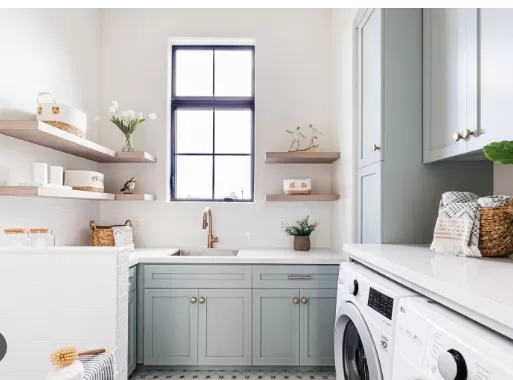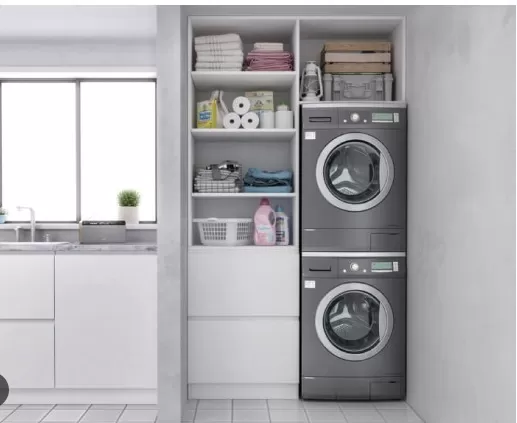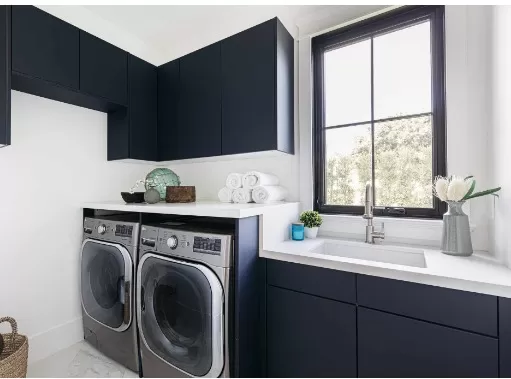Laundry Room Planning: Essential Guide. Transform your laundry room from a mundane chore space into a cheerful, well-organized, and efficient area that makes doing the wash a more enjoyable experience. With a few simple changes, you can breathe new life into this essential but often overlooked room.
Add a fresh coat of paint in vibrant colors, hang artwork or inspirational quotes to create a cheerful ambiance, and invest in practical storage solutions to keep everything organized and within reach. Consider installing shelves, cabinets, or baskets for sorting and storing laundry items. Optimize the layout by arranging appliances in a way that maximizes functionality and workflow. Don’t forget to incorporate proper lighting and comfortable seating to make the room more inviting. By revamping your laundry room, you can turn a mundane task into a more pleasant and efficient experience.
Strategic Placement: Locating the Laundry Room for Convenience and Functionality

Traditionally, laundry rooms were situated in the basement due to the noise generated by washers and dryers.
However, with advancements in technology, modern laundry machines have become quieter. As a result, homeowners now have the flexibility to locate the laundry room closer to the main Living Areas, such as bedrooms and bathrooms, for added convenience.
When planning the location of your laundry room, consider the following factors:.
Noise Considerations: With quieter laundry machines available, you have the option to position the laundry room closer to main living areas.
Placing it near bedrooms or bathrooms can make the task of doing laundry more convenient, as it minimizes the need to transport laundry to and from different floors of the house.
Plumbing and Ventilation Requirements: Laundry equipment requires both a plumbing hookup and ventilation to the outdoors.
When determining the location, consider proximity to existing water supply pipes to avoid the need for extensive plumbing work. It is advisable to consult with a plumber to ensure proper installation and compliance with local building codes.
Additionally, check if a plumbing vent is required to allow air to escape the system, as per the regulations in your area.
Accessibility and Convenience: Choose a location that is easily accessible for carrying laundry baskets and linens.
Consider the flow of household traffic and aim for a space that streamlines the process of washing and drying clothes. Placing the laundry room near bedrooms or bathrooms where clothing tends to be changed can simplify the chore of laundry.
Space Availability: Assess the available space in your home to determine the best location for the laundry room.
It should provide enough room for the washer, dryer, storage cabinets, and any additional features you require, such as folding tables or hanging racks. Ensure that the area allows for proper ventilation and sufficient space for easy maintenance and repairs if needed.
By strategically locating the laundry room closer to main living areas, you can enhance convenience and streamline your laundry routine.
Remember to consider plumbing and ventilation requirements, accessibility, and available space when making this decision. With a well-planned location, your laundry room can become an efficient and functional space within your home.
So, take advantage of quieter laundry machines and consider locating your laundry room closer to main living areas.
Keep in mind the plumbing and ventilation needs, accessibility, and available space to ensure a convenient and efficient laundry experience. By strategically placing your laundry room, you can simplify the process and make this essential household task more manageable.
Choosing the Right Flooring for Your Laundry Room
When selecting flooring for your laundry room, several factors come into play, including affordability, durability, maintenance, and aesthetic appeal.
Consider the following flooring options to create a functional and visually pleasing space:.
Vinyl or Linoleum: Vinyl and linoleum are traditional and popular choices for laundry room flooring.
They are affordable, low-maintenance, and resistant to water and stains. They provide a durable surface that is easy to clean and can withstand the wear and tear of a laundry room.
Cork Flooring: Cork flooring has gained popularity as homeowners seek to add warmth and style to their laundry rooms.
It is a handsome and hard-wearing material that offers natural insulation and cushioning underfoot. Cork is also relatively inexpensive and environmentally friendly, making it an attractive option for those looking to humanize their laundry space.
Rubber Mat Flooring: Rubber mat flooring, commonly used in fitness gyms, is another viable choice for laundry rooms.
It is quick to install, provides sound-muffling properties, and offers a comfortable surface for prolonged standing. Rubber flooring is also water-resistant and easy to clean, making it suitable for the laundry room environment.
Consider your specific needs and preferences when choosing the flooring for your laundry room.
Evaluate factors such as budget, desired aesthetics, maintenance requirements, and the level of durability required. Also, consider the amount of foot traffic and potential exposure to water or spills in the laundry room.
By carefully selecting the right flooring, you can create a functional and visually appealing laundry room that enhances your overall laundry experience.
So, explore flooring options such as vinyl, linoleum, cork, or rubber mat to find the ideal choice for your laundry room.
Consider factors like affordability, durability, maintenance, and aesthetic appeal to create a practical and stylish flooring solution that suits your needs. With the right flooring, your laundry room will not only be functional but also a pleasant space that adds value to your home.
Maximizing Storage in Your Laundry Room

To keep your laundry room organized and minimize clutter, consider incorporating storage solutions that adapt well to the space.
Closet storage organizers and kitchen cabinets can be repurposed to meet your laundry room storage needs. Follow these tips to create an efficient and tidy laundry room:.
Utilize Closet Organizers and Cabinets: Explore options from closet storage organizers and kitchen cabinets to maximize storage in your laundry room.
These solutions offer compartments and shelves to store laundry essentials, such as detergents, fabric softeners, and cleaning supplies. Look for cabinets and organizers that fit the dimensions of your space and install them to suit your storage requirements.
Wall-Mounted Units: Make use of wall-mounted units above the washer and dryer to conserve valuable floor space.
These units can provide additional storage for items like laundry baskets, ironing supplies, or folded clothes. Install shelves or cabinets that complement the overall design of your laundry room and allow for easy access to frequently used items.
Permanent Hanging Rack: If you have the available space, set up a permanent hanging rack to hang clothes as they come out of the dryer.
This will help prevent wrinkles and minimize the need for ironing. Additionally, the rack can be used to air-dry delicate items.
Consider installing a dehumidifier or exhaust fan to reduce moisture in the air, ensuring optimal drying conditions.
Consider Additional Storage Solutions: Depending on your laundry room’s layout and available space, you may want to explore other storage options.
This could include over-the-door organizers, rolling carts, or storage bins to further streamline and organize your laundry supplies.
Ensure that your storage solutions are installed securely and are easily accessible for a seamless laundry routine.
Regularly declutter and organize the storage areas to maintain an efficient and functional space.
By incorporating these storage ideas, you can create a well-organized laundry room that minimizes clutter and enhances productivity.
So, repurpose closet organizers and kitchen cabinets, install wall-mounted units, and consider a permanent hanging rack to optimize storage in your laundry room.
Explore additional storage solutions that suit your needs and keep the space organized. With a well-planned storage system, your laundry room will become a functional and efficient area that simplifies your laundry tasks.
Illuminating Your Laundry Room: Enhancing Visibility and Ambiance
Proper lighting in your laundry room is crucial for effective stain treatment, ironing, and overall visibility.
Consider the following tips to ensure optimal lighting in your laundry space:.
Task Lighting: Install task lighting that provides focused illumination for specific work areas.
Track lighting is an excellent option as it offers multiple adjustable heads, allowing you to direct light precisely where it is needed. Position the lights strategically to illuminate the stain-treating area, ironing board, and other workstations in the room.
Natural Light: If possible, take advantage of natural light by incorporating windows in your laundry room.
Windows not only bring in fresh air and help release humidity, but they also provide valuable ambient light. Natural light creates a bright and inviting atmosphere, making tasks easier and reducing the strain on your eyes.
Lighting Placement: Place lights strategically to avoid casting shadows on your work surfaces.
Consider installing overhead lighting fixtures or recessed lighting to evenly illuminate the entire room. Supplement this with task lighting where necessary to ensure specific areas are well-lit.
Light Bulb Selection: Choose light bulbs that emit a bright, white light to mimic natural daylight.
LED bulbs are energy-efficient and offer excellent color rendering, allowing you to see colors accurately and distinguish stains or wrinkles more effectively. Aim for a balance between warm and cool light to create a comfortable and functional space.
Dimmer Switches: Install dimmer switches for your laundry room lighting.
This gives you the flexibility to adjust the brightness according to your needs and preferences. Lower lighting levels can create a relaxing ambiance during non-work hours or when you want a softer glow in the room.
Task-Specific Lighting: Consider additional lighting solutions for specific tasks.
For example, install under-cabinet lighting near the sink or countertop for better visibility while treating stains. A well-lit ironing station can enhance your ironing experience and ensure proper wrinkle removal.
By implementing these lighting strategies, you can improve visibility, enhance ambiance, and create a functional and inviting laundry room.
So, incorporate task lighting, make use of natural light through windows, and strategically place overhead lighting to illuminate your laundry room effectively.
Choose light bulbs with accurate color rendering and consider adding dimmer switches for versatility. By prioritizing proper lighting, you’ll enhance visibility, create a pleasant atmosphere, and optimize your laundry routines.
Soundproofing Your Laundry Room: Creating a Tranquil Space

Laundry machines can produce significant noise, resembling an alien spacecraft revving for takeoff.
To minimize noise transmission and create a peaceful environment in your laundry room, consider implementing the following soundproofing measures:.
Double Layered Wallboard: Install two layers of wallboard on the walls and ceilings of your laundry room.
This double layer helps to suppress noise more effectively than a single layer. Choose sound-dampening drywall or add an additional layer of standard drywall to create a thicker barrier against sound transmission.
Insulate Wall Cavities and Floor Joists: Fill the cavities between wall studs and floor joists with insulation materials such as fiberglass, rigid foam, or spray insulation.
These materials help absorb and reduce sound vibrations, preventing noise from escaping the laundry room and reaching adjacent rooms or levels in your home.
Seal Gaps and Openings: Ensure that any gaps, cracks, or openings in the walls, ceilings, or floors of your laundry room are properly sealed.
Use caulk or weatherstripping to seal around windows, doors, and utility openings. This helps to further prevent sound leakage and maintain a quieter environment.
Soundproofing Underlayment: Consider using a soundproofing underlayment beneath the flooring in your laundry room.
These specialized materials help reduce impact noise and vibrations caused by the washer or dryer. Soundproofing underlayment can be particularly beneficial if your laundry room is located on an upper floor or above living spaces.
Additional Soundproofing Measures: Explore other soundproofing techniques, such as installing sound-absorbing panels on walls, adding heavy curtains or drapes to windows, or using soundproofing materials on doors.
These measures can further enhance sound insulation in your laundry room.
By implementing these soundproofing techniques, you can significantly reduce noise transmission from your laundry machines and create a more tranquil laundry room environment.
So, incorporate double-layered wallboard, insulation in wall cavities and floor joists, and seal gaps and openings to minimize sound transmission in your laundry room.
Consider using soundproofing underlayment and explore additional measures like sound-absorbing panels or heavy curtains for further sound insulation. With these soundproofing measures, you’ll enjoy a quieter laundry room and reduce disturbances in your home.
*The information is for reference only.